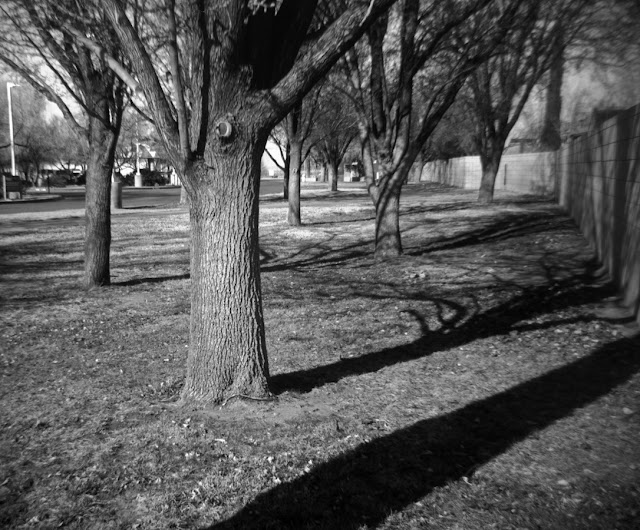The metal bodied Flash Six-20 was an outlier in Kodak's post-war plastic Brownie lineup. Perhaps the choice of materials was related to the sudden availability of steel for consumer products. I loaded mine with a roll of well-expired Ilford Pan F 50 for a neighborhood stroll. As I walked out the door I was thinking about the fact that I had not tried the camera's built-in close-up lens, so I snapped a shot of our deck furniture as a test, which the Six-20 passed comfortably. The next two shots gave me some dull, blurred results. I'm not sure if I misjudged the distance, or just didn't hold the camera steady enough to accommodate the slow shutter speed.
I switched back to the camera's "Beyond 10 Feet" setting and got a nicely sharp rendering of some winter- bare trees. However, the left fifth of the image was black -- don't know why.
I stuck with the non-close setting for the rest of the roll and the following full-frame images nicely illustrate the central sharpness of the meniscus lens along with some corner vignetting and blurred periphery.
I got to the Plaza Vieja in Old Town with just one frame left, which was good luck as Elvis was making a rare appearance there for a small group of devoted fans.






6 comments:
I had one of these cameras in my collection in the 80s. I wasn't sure mine was fully in working order, which is why I never put film through it. You could still buy 620 film at the drug store then, but I recall it being quite expensive, something like six dollars a roll. Your photos are the only ones I've ever knowingly seen from one of these cameras.
A contemporary of Elvis!
Not my favorite Brownie, but it got the job done.
I recall listening to Elvis on the radio while cruising with my highschool friends in my '52 Ford.
The photograph of the deck furniture turned out really well. I'm impressed considering what a simple lens this camera has. Does this camera have a leaf shutter or some sort of primitive spinning disk that spins in front of the film?
Just the usual rotating disk shutter common to box cameras. The built-in close-up lens may add a bit of sharpness, though I think it only gets you down to about five feet. The manual shows that an additional accessory lens for portaiture was available. Several companies made similar metal box cameras in the 1950s; I think the Agfa Clack may have been the best, and it uses standard 120. The roll of expired Pan F which you provided was the last b&w I had in the refrigerator suitable for box camera shutter speeds.
Post a Comment